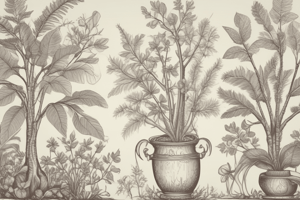Podcast
Questions and Answers
What is a key adaptation of aquatic plants that allows them to thrive in their environment?
What is a key adaptation of aquatic plants that allows them to thrive in their environment?
- Broad leaves that float on water (correct)
- Thick cuticles on their leaves
- Extensive root systems for absorption
- Strong woody stems for support
What advantage do aquatic plants have due to their surrounding environment?
What advantage do aquatic plants have due to their surrounding environment?
- Need for extensive vascular tissues
- Abundance of water for absorption (correct)
- Lack of competition for nutrients
- Requirement for deep anchoring roots
How do adaptations of plants in moving water typically differ from those in still water?
How do adaptations of plants in moving water typically differ from those in still water?
- They grow larger roots for stability
- They feature narrow leaves to reduce water resistance (correct)
- They have wider leaves to increase buoyancy
- They develop thicker stems for support
What adaptation do water lilies have to maximize sunlight collection?
What adaptation do water lilies have to maximize sunlight collection?
Which of the following adaptations would NOT be necessary for aquatic plants?
Which of the following adaptations would NOT be necessary for aquatic plants?
What is a primary adaptation of the saguaro cactus to survive in arid environments?
What is a primary adaptation of the saguaro cactus to survive in arid environments?
Which feature of epiphytes aids them in obtaining sunlight?
Which feature of epiphytes aids them in obtaining sunlight?
How do the leaves of bromeliads assist them in water collection?
How do the leaves of bromeliads assist them in water collection?
What adaptation helps xerophytes prevent water loss?
What adaptation helps xerophytes prevent water loss?
What benefit do epiphytes gain from being elevated on host trees?
What benefit do epiphytes gain from being elevated on host trees?
Aloes are known for their adaptations that allow them to store water in their enlarged fleshy leaves.
Aloes are known for their adaptations that allow them to store water in their enlarged fleshy leaves.
Aquatic plants need extensive root systems and vascular tissues to absorb and transport water effectively.
Aquatic plants need extensive root systems and vascular tissues to absorb and transport water effectively.
Water lilies have adaptations that allow their flowers to float above the water's surface for pollination.
Water lilies have adaptations that allow their flowers to float above the water's surface for pollination.
Plants living in moving water, like stream plants, develop wider, leaf structures to counteract strong water currents.
Plants living in moving water, like stream plants, develop wider, leaf structures to counteract strong water currents.
All living plants today have evolved adaptations that allow them to thrive in water environments.
All living plants today have evolved adaptations that allow them to thrive in water environments.
Aquatic plants generally need strong woody stems to thrive in their environment.
Aquatic plants generally need strong woody stems to thrive in their environment.
Aloes are adaptations that allow them to store water in enlarged fleshy leaves.
Aloes are adaptations that allow them to store water in enlarged fleshy leaves.
Most aquatic plants have evolved to develop extensive root systems.
Most aquatic plants have evolved to develop extensive root systems.
Cattails have narrow, strap-like leaves to help them resist strong water currents.
Cattails have narrow, strap-like leaves to help them resist strong water currents.
Water lilies have adaptations to keep their flowers above water for effective pollination.
Water lilies have adaptations to keep their flowers above water for effective pollination.
Flashcards are hidden until you start studying
Study Notes
Adaptations of Aloe Plants
- Aloe plants are succulents with fleshy leaves, stems, or roots that store water.
- This adaptation enables survival in arid environments.
General Plant Adaptations
- Plants are found in diverse habitats due to evolved adaptations for survival and reproduction.
- All modern plants descended from terrestrial ancestors, yet some have adapted to aquatic environments.
Aquatic Plant Adaptations
- Aquatic plants thrive in water, benefiting from abundant water availability.
- Most do not develop extensive root systems or thick cuticles, saving energy and materials.
- Water's buoyancy reduces the need for strong stems and deep roots.
- Pollination adaptations often include keeping flowers above water; for example, water lilies have bowl-shaped flowers.
- Water lilies possess broad, flat leaves to maximize sunlight exposure.
- Plants in moving water, like cattails, have narrow leaves to minimize resistance against currents.
Xerophyte Adaptations for Extreme Dryness
- Xerophytes are plants adapted to dry environments, optimizing water intake and minimizing loss.
- The saguaro cactus exemplifies these adaptations, extending shallow roots up to 2 meters (7 feet) for moisture collection.
- Lacking leaves reduces transpiration; its barrel-shaped stem stores large water reserves.
- Thorns deter animals from consuming the stem's water.
Epiphyte Adaptations in Canopy Environments
- Epiphytes, such as certain ferns and orchids, grow on other plants and do not rely on soil for nutrients or support.
- Elevated positions allow access to sunlight and reduce herbivore threats.
- Rainforest epiphytes absorb moisture from the humid air, facilitating photosynthesis.
- Modified leaf structures, like bromeliads with funnel-shaped leaves, collect rainwater.
- Bromeliads can hold over 8 liters (2 gallons) of water, which also supports local insect and amphibian life, providing additional nutrients.
Summary
- Plants display a wide array of adaptations to thrive in various environments, including water, extreme dryness, and as epiphytes.
Adaptations of Aloe Plants
- Aloe plants are succulents with fleshy leaves, stems, or roots that store water.
- This adaptation enables survival in arid environments.
General Plant Adaptations
- Plants are found in diverse habitats due to evolved adaptations for survival and reproduction.
- All modern plants descended from terrestrial ancestors, yet some have adapted to aquatic environments.
Aquatic Plant Adaptations
- Aquatic plants thrive in water, benefiting from abundant water availability.
- Most do not develop extensive root systems or thick cuticles, saving energy and materials.
- Water's buoyancy reduces the need for strong stems and deep roots.
- Pollination adaptations often include keeping flowers above water; for example, water lilies have bowl-shaped flowers.
- Water lilies possess broad, flat leaves to maximize sunlight exposure.
- Plants in moving water, like cattails, have narrow leaves to minimize resistance against currents.
Xerophyte Adaptations for Extreme Dryness
- Xerophytes are plants adapted to dry environments, optimizing water intake and minimizing loss.
- The saguaro cactus exemplifies these adaptations, extending shallow roots up to 2 meters (7 feet) for moisture collection.
- Lacking leaves reduces transpiration; its barrel-shaped stem stores large water reserves.
- Thorns deter animals from consuming the stem's water.
Epiphyte Adaptations in Canopy Environments
- Epiphytes, such as certain ferns and orchids, grow on other plants and do not rely on soil for nutrients or support.
- Elevated positions allow access to sunlight and reduce herbivore threats.
- Rainforest epiphytes absorb moisture from the humid air, facilitating photosynthesis.
- Modified leaf structures, like bromeliads with funnel-shaped leaves, collect rainwater.
- Bromeliads can hold over 8 liters (2 gallons) of water, which also supports local insect and amphibian life, providing additional nutrients.
Summary
- Plants display a wide array of adaptations to thrive in various environments, including water, extreme dryness, and as epiphytes.
Adaptations of Aloe Plants
- Aloe plants are succulents with fleshy leaves, stems, or roots that store water.
- This adaptation enables survival in arid environments.
General Plant Adaptations
- Plants are found in diverse habitats due to evolved adaptations for survival and reproduction.
- All modern plants descended from terrestrial ancestors, yet some have adapted to aquatic environments.
Aquatic Plant Adaptations
- Aquatic plants thrive in water, benefiting from abundant water availability.
- Most do not develop extensive root systems or thick cuticles, saving energy and materials.
- Water's buoyancy reduces the need for strong stems and deep roots.
- Pollination adaptations often include keeping flowers above water; for example, water lilies have bowl-shaped flowers.
- Water lilies possess broad, flat leaves to maximize sunlight exposure.
- Plants in moving water, like cattails, have narrow leaves to minimize resistance against currents.
Xerophyte Adaptations for Extreme Dryness
- Xerophytes are plants adapted to dry environments, optimizing water intake and minimizing loss.
- The saguaro cactus exemplifies these adaptations, extending shallow roots up to 2 meters (7 feet) for moisture collection.
- Lacking leaves reduces transpiration; its barrel-shaped stem stores large water reserves.
- Thorns deter animals from consuming the stem's water.
Epiphyte Adaptations in Canopy Environments
- Epiphytes, such as certain ferns and orchids, grow on other plants and do not rely on soil for nutrients or support.
- Elevated positions allow access to sunlight and reduce herbivore threats.
- Rainforest epiphytes absorb moisture from the humid air, facilitating photosynthesis.
- Modified leaf structures, like bromeliads with funnel-shaped leaves, collect rainwater.
- Bromeliads can hold over 8 liters (2 gallons) of water, which also supports local insect and amphibian life, providing additional nutrients.
Summary
- Plants display a wide array of adaptations to thrive in various environments, including water, extreme dryness, and as epiphytes.
Studying That Suits You
Use AI to generate personalized quizzes and flashcards to suit your learning preferences.




